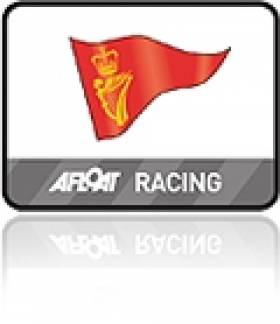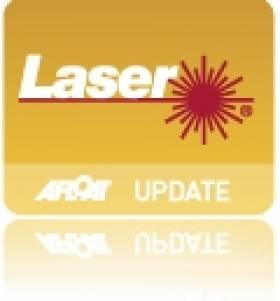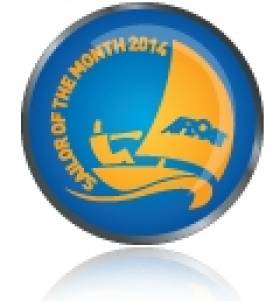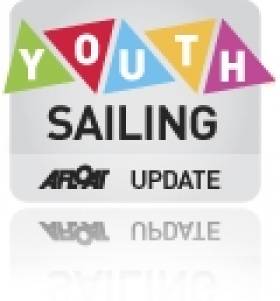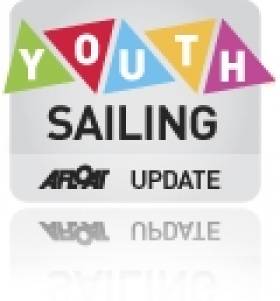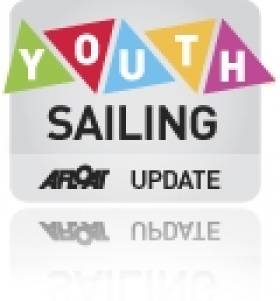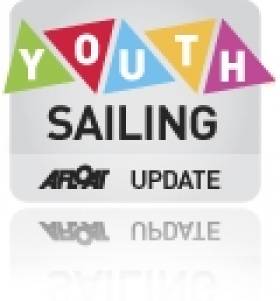Displaying items by tag: Seafra Guilfoyle
Royal Cork Yacht Club Awards Laser Youth Sailor Seafra Guilfoyle
#royalcork – ISAF Youth Silver Medallist Séafra Guifoyle has won the Pyewacket Cup for the fourth time at Royal Cork Yacht Club writes Claire Bateman. Royal Cork's Guilfoyle has topped off a magnificent period of sailing and received the well deserved accolade of being awarded the Pyewacket Perpetual Cup. His silver medal achievement at the ISAF Youth world Championships at Tavira, Portugal in July was well recognised by the Munster club's adjudicating Committee. He showed true grit in producing a final race win in the series, his seventh top ten placing resulting in the silver medal, Ireland's second in as many years.
He had got off to a great start in the light wind series and scored an opening race win plus a fifth in race two and held this lead until the half way stage. "I nearly had gold but at the last minute Joel Rodriquez moved to finish fourth." This was enough for Rodriquez to take the gold and, to quote Séafra again, "I tried my best and am still thrilled with the result."
At Optimist level Séafra was National Champion in 2008 and 2009 and in 2011 he moved to a Laser 4.7 and became Class National Champion in that year.
In October 2001 the late Roy Disney, widely known American Sailing Enthusiast who had a home in West Cork, had strong ties with the Royal Cork Yacht Club, and participated in many Ford Cork Week Regattas, presented the club with the Pyewacket Perpetual Cup at a dinner in the club hosted by the then Admiral, Anthony O'Leary.
The Pyewacket Trophy is presented each year to the youth sailor, who in the opinion of the Adjudicating Committee , has achieved the best results overall in his or her class. and took place on November 14th at the highly successful and enjoyable Junior Laying Supper at the Royal Cork Yacht Club.
Wind Aplenty for Tomorrow's Laser Nationals At Ballyholme Yacht Club
#laser – Tomorrow sees the start of the 2014 Zhik sponsored Irish Laser National Championships at Ballyholme Yacht Club (BYC) on Belfast Lough writes BYC's Mark Mackey.
The top Northern Ireland dinghy club is now expecting 130 boats with competition across all three fleets, especially at the top of the Laser Standard and Laser Radial fleets.
In the Standards, Olympian and multiple Irish National Laser Champion James Espey will fend off Finn Lynch who was crowned Under 19 World Champion last week with fellow squad sailors Fionn Lyden and Darragh O'Sullivan hot on their heels.
In the Radials, Olympian Annalise Murphy will have ISAF World Youth Silver medallist Seafra Guilfoyle to contend with as well as a host of Ballyholme YC's best Radials including Ryan Glynn (4th in UK Nationals), his brother Liam who was last year's Topper World Champion and Tim Brow, son of Event Organiser Paddy Brow and 7th in the UK Nationals.
Also look out for Ballyholme's Sarah Eames who has spent the summer competing across Europe at the ISAF Worlds, European Youth and World Under 19 Championships.
A mixture of conditions is forecast over the next 4 days with plenty of wind tomorrow afternoon and Friday. Expect to see Annalise excel in the breeze as always against the best of the boys, and catch most of those in the Standard fleet who start five minutes before her.
Ballyholme Prepares for Belfast Lough Laser Nationals
#laser – Next week will see one of the most competitive sailing events seen in Northern Ireland for several years as the Olympic Laser class hosts its Irish Championships on Belfast lough.
This summer has seen the best Laser Radial sailors from Ireland including many well know faces from Bangor compete across Europe. Séafra Guilfoyle from Cork won the Silver medal at the ISAF Youth World Championships in Portugal where Sarah Eames also competed. Seafra and 6 members from Ballyholme YC also competed at the World Youth Championships in Poland where Seafra came 7th. BYC's Ryan Glynn has just returned from the UK Laser Radial Nationals at Largs, Scotland with 4th place. Brother (and last year's Topper World Champion) Liam Glynn was 5th (2nd Youth), Tim Brow was 7th while Laura Gilmore from SLYC was 1st Youth Lady in a fleet of 86 boats.
Ballyholme Yacht Club will host the Zhik Irish Laser National Championships from 28 - 31st August 2014 - all of the RYANI and ISA youth squads should be in attendance for the Radial championship and a number of the GB squad will also be competing. BYC has one of the largest Laser fleets in Ireland with over 50 regularly competing in club racing and their Icebreaker series over the winter. The 2013 Irish Laser Nationals had over 120 entries. Event Organiser Paddy Brow and Race Officer Robin Gray will ensure a great series of racing and socialising off the water.
The Laser is the most popular single handed dinghy in the world and an Olympic dinghy. There are 3 fleets - Standard, Radial and 4.7 - which use the same boat but have different sail sizes for different size and weight of crew. The Standard is a men's Olympic dinghy - James Espey from Ballyholme YC represented Ireland at London 2012 - and the Radial is the female Olympic dinghy - Annalise Murphy from National YC came 4th at the London Olympics. The 4.7 is a major youth pathway dinghy worldwide.
Today (Wednesday 20th) is the last day for Early Entry Discount and Online Registration.
Seafra Guilfoyle, Afloat's Sailor of the Month for July
#sailorofthemonth – The Royal Cork Yacht Club's Cup of Success was running over in July, as the Commodore's Cup victory followed on to a Silver Medal at the ISAF Worlds for 18-year-old Seafra Guilfoyle of Crosshaven, who is now the Afloat.ie "Sailor of the Month".
Racing in the boys Laser Radials at the Youth Worlds at Tavira on the Algarve in Portugal from July 14th to 20th, by the last day Guilfoyle was certain of a medal, with the final race to decide which one. As it happened, he came tantalisingly close to Gold.
During the week, after winning the first race, he topped the leaderboard for much of the series. But the last day's racing started with the points leadership held by Joel Rodriguez Perez of Spain 7 points ahead of Guilfoyle, who was now third as Ryan Lo of Singapore had moved up to second.
Yet the Irish helmsman sailed like a champion, and headed the fleet throughout that final contest, with the two other main contenders well down the line It looked as though the Gold was Guilfoyle's. But then Perez battled his way up the fleet, and went like a train in the final stages to get up to fourth and take the Gold by four points, with Guilfoyle solidly placed in second overall for the Silver, the third medal for Ireland in the last two years in the ISAF Youth Worlds.
Black Flag on the Baltic Costs Seafra Guilfoyle Top Five Finish at Radial Youth Worlds
#laserradial – A black flag disqualification in the second race of the Laser Radial Youth World Championships in Poland ruined Seafra Guilfoyle's ambition of a second youth medal this summer last week.
Despite the unlucky error, the plucky Crosshaven under–18 sailor, who took silver at the ISAF Youth Worlds in Portugal a fortnight ago, has again scored a series of top ten results in a strong 159–boat fleet.
Guilfolye was part of a seven boat Irish team.
After the black flag result, the Royal Cork Yacht Club sailor was lying 16th in Dziwnow but by Saturday's finish, in a measure of his speed and determination, the former Irish Optimist champion, had moved up to seventh overall.
'A black flag cost me a top 5 finish at worlds but still happy with seventh place. Looking forward to a few days off now', he concluded on Saturday.
A poor quality event website is here with a broken results link.
#youthworlds – Here's a wrap up highlight video from the ISAF Youth Worlds Laser Radial Boys and Girls fleets. Joel Rodriguez and Martina Reino made it a double Spanish victory in the Laser Radial fleets but it was a week in which Ireland's Seafra Guilfoyle topped the leaderboard taking silver in the last race.
The 2014 ISAF Youth Sailing World Championship has set new grounds for the regatta with Tavira, Portugal playing host to a record number of nations and sailors as the curtain was drawn on the event at the closing ceremony.
Tavira's Town Hall square played host to the closing ceremony on 18 July and saw the achievements of all 367 sailors from 67 nations celebrated.
Spain lifted the Nations Trophy for the first time in their history as they celebrated four medals from the eight classes racing in the Algarve.
Five days of intense competition saw 86 races completed with the finest youth sailors on the planet taking the honours.
The ISAF Bengt Julin Trophy was awarded to South Africa's Brandon Wijtenburg and Todd Fisher who had demonstrated good sportsmanship, respect, graciousness, helpfulness and friendliness to their fellow competitors.
First awarded in 1990, the ISAF Bengt Julin Trophy is a unique trophy which is awarded to a competitor or a National Team that has done the most to foster understanding and displaying attributes that are encouraged at the ISAF Youth Worlds.
Wijtenburg and Fisher were nominated by their peers and received the award from ISAF Vice President Nazli Imre.
Alongside the medal presentations special thanks was given to event sponsors, volunteers and boat suppliers who made the 44th edition of the ISAF Youth Worlds possible.
ISAF Vice-President Nazli Imre closed the event and handed the ISAF flag over to Langkawi, Malaysia, host venue of the 2015 ISAF Youth Worlds.
#youthworlds – The pre-race guarantee of a medal did nothing to stop Seafra Guilfoyle's final bid to reclaim his week long lead at the ISAF youth woulds in Tavira, Portgual this afternoon. In the end the Royal Cork 18–Year–old sailed superbly to win race nine but it was not ernough to catch Spain's Joel Rodriguez who took the Gold. Gulfoyle matched Ireland's only other ISAF youth silver when he overhauled Ryan Lo of Singapore.
Guilfoyle competed against 56 other nations in the boys Laser Radial class to become the third ever Irish sailor to medal at this prestigious event.
"This morning I knew I had a medal secured so I had nothing to lose. My plan with my coach Russell was to sail as fast as I could and I went out there and won the race. I nearly had gold but in the last minute Joel moved up to finish fourth. I tried my best and I'm still thrilled with the result. I've the Laser Radial Worlds next week in Poland so hopefully I can medal there too".
Racing began on Monday in Tavira and Séafra was quick to set the tone for the week, winning the first race and propelling himself to the top of the leader board. During the first three days of the championship Séafra remained untouched in pole position after six races. Then, dramatically, a 16th in yesterday's penultimate race saw the teenager slip to third for the first time. However Séafra had already generated enough of a points lead to guarantee himself a spot on the podium.
The final deciding race began this afternoon shortly before 1pm in 11 knots. Séafra, overnight leader Joel Rodriguez Perez from Spain and Ryan Lo from Singapore – separated by only seven points - were all in contention for Gold. A battle between the trio unfurled off the Algarve coast but it was Séafra who came out on top to win the final race. Rodriguez Perez finished fourth putting him four points clear of Guilfoyle to claim the Gold.
In 2012 Séafra's former ISA Academy teammate Finn Lynch won Silver, prior to which only bronze had been claimed by duo Ciara Peelo and Laura Dillon in 1996. Finn is now sailing full-time and will compete at the Olympic qualifiers in September with the 2016 Rio Olympics firmly in his sights.
The ISAF Youth Worlds is widely recognised as being the equivalent of the youth sailing Olympics. Only one sailor is allowed to compete per nation in each class with Séafra having qualified to represent Ireland earlier this year.
#youthworlds – Ireland's Seafra Guilfoyle lost his lead in the dying airs of race eight of the ISAF Youth worlds last night but is still in the fight for Ireland's first youth gold medal at Tavira, Portugal today. A ten point cushion rapidly turned into a seven point deficit as Guilfoyle counted a 7 and a 16 in more light winds yesterday.
It will go down to the final day in the Laser Radial Boys and Girls fleets with very few points separating the leading racers.
Joel Rodriguez (ESP) leads Singapore's Ryan Lo whilst Seafra Guilfoyle (18), who had led from the opening day, falls down to third. The top three have all guaranteed themselves a medal but with seven points of separation the final race will decide the honours.
Race victories went the way of Lo and Jonatan Vadnai (HUN) who is sixth overall.
The top four in the Laser Radial Girls fleet are all in with a shout of claiming an ISAF Youth Worlds medal. Nine points divide Martina Reino (ESP), in first, Haddon Hughes (USA), Maud Jayet (SUI) and Monika Mikkola (FIN).
The days bullets were picked up by Julia Kuhn (GER) and Hughes.
Ireland have enjoyed previous podium success at the 'Olympics' of Under–18 sailing but until now success has been decades apart. There was bronze in the Laser II double–hander in 1996 and Laser Radial silver on home waters 16 years later but youth gold has always evaded Ireland.
More on this in the Irish Times here
Spain's Silvia Mas Depares and Marta Davila Mateu clinched 420 Girls gold with a race to spare on the penultimate day of racing at the 2014 ISAF Youth Sailing World Championship.
The Spanish team have been sensational on the water and sealed the deal with a bullet and a sixth.
Many of the sailors across the remaining seven fleets have guaranteed themselves a medal but the colours are to be decided on the final day with one race on the cards for each fleet.
Tavira's breeze arrived fashionably late but when it came in it remained consistent from the south west building to 10-12 knots.
420
Spain's Silvia Mas Depares and Marta Davila Mateu wrapped up gold in the 420 Girls fleet after a dominant display on the penultimate day.
A bullet and a sixth leaves them with an unassailable 13 point lead over the chasing pack and they were delighted after racing, "Every sailor always dreams about winning a World Championship and this is awesome for us," said Mas.
"It's something you train hard for all year and now we're here and now I know we have won. It's something you can't imagine. It's almost like it's not true and I'm very happy."
A beaming Davila added, "Just being here is amazing but winning it, it's unbelievable. We've won an ISAF Youth Worlds!"
Israel's Yahel Wallach and Stav Brokman have had a strong two days of racing and with a race to go they have sealed silver.
The race is on for bronze with any of the teams placed from third to eighth mathematically able to win gold. As it stands Theres Dhnke and Birte Winkel (GER) hold third spot.
It's a different outlook in the 420 Boys fleet with five points separating the top four. The lead has exchanged hands numerous times throughout the week but heading into final day in pole position is Japan's Ibuki Koizumi and Kotaro Matsuo.
Many of the teams struggled for consistency on the penultimate day but Singapore's Yia Jia Loh and Jonathan Yeo found some form and posted a first and a sixth to advance into silver medal position.
Overnight leaders Diogo Pereira and Manuel Macedo (POR) fell to fourth overall following an 18th and an eighth. Malaysia's Mohammad Faizal Norizan and Ahmad Syukri Abdul Aziz occupy the final podium spot heading into the final day.
RS:X
There is just one point separating China's Shi Hongmei and Russia's Sefaniya Elfutina in the RS:X Girls with one race remaining. There has been very little separating the top four racers in the RS:X Girls fleet and it will go down to the final day to decide medals.
Italy's Marta Maggetti is six points off the Chinese leader with Pilar Lamadrid (ESP) six points behind the Italian in fourth.
The Spanish racer took the first bullet of the day but it could have been a different story as she explained, "Today was my best day but I could have done it better. I was first in the last race and second in the middle race but finally the girls but passed me but it's okay. I like this wind and I think tomorrow it will be better.
"The first day I was a bit nervous so I didn't have good racing with a seventh and a sixth but then on the other days I improved and I was less nervous and today I was able to win another race. I feel really good because I was at the top with all the good girls."
Israel's Yael Paz continues to lead the RS:X Boys fleet and sits atop of the pile on 18 points, four ahead of Mattia Camboni (ITA).
It could have been the perfect day for Camboni with three straight bullets but it was not to be as he explained, "Today was a really good day. I had three firsts but in the first one I was disqualified but I am still second. It was a really good day, the sun was okay and the breeze was quite good."
Camboni discards his UFD and having previously discarded a sixth he is still within sight of the Israeli. For him to overthrow Paz, Camboni has to finish first or second on the last day and hope the Israeli finishes sixth or lower. Whether it's gold or silver Camboni has thrived in his environment, "This event, it's the best of my life. This is my fourth and last ISAF Youth Worlds so I want to win but if I don't wind it's a nice experience."
SL16
Louis Flament and Charles Dorange (FRA) have an 11 point lead in the SL16 fleet heading into the final day. The French pair discard an OCS and having picked up a ninth on the penultimate day it will all boil down to the final bout.
Jordi and Ruben Booth (ESP) reduced the French duos overnight 15 point lead by four with a steady racing day but will be hard pressed to overthrow them in a single race on the last day. The French and Spanish teams have guaranteed themselves a medal but the colour is to be decided.
Brazil's Kim Vidal and Antonio Lopes hang on to third place overall by three points. America's Ravi Parent and Nicholas Schultz (USA) pulled to within touching distance of the Brazilians and will have one eye on them in the final race.
29er
Quinn Wilson and Riley Gibbs (USA) moved into pole position in the 29er after the French frontrunners had a disastrous day.
Brice Yrieix and Loic Fischer Guillou had an 18 point advantage going into the day but a discarded disqualification and a 14th sees them slip to second.
From two 29er races the Americans were strong and focused and posted a third and a bullet. They lead on 41 points followed by the French on 42 points.
Markus Somerville and Isaac Mchardie (NZL) are within touching distance of the top two on 48 points.
One single race in both fleets is scheduled to commence at 13:00 local time.
View results here.
#youthsailing – New Irish youth sailing star Seafra Guilfoyle has extended his lead in the 53-boat Laser Radial class at the ISAF youth worlds in Tavira, Portugal this afternoon. The Royal Cork single-hander has a three–point cushion over Martin Lowy (BRA) and Denmark's Patrick Dieter following two days of competition.
It was a late start and a late finish on the second day of competition with the last competitors reaching the shore at 21:00 local time.
The breeze came in late in the day and the first start came at 16:01 local time before the final competitors reached the shore at 21:00.
A light yet consistent westerly breeze ensured all eight fleets completed a full complement of races on the Algarve to shape up the leader boards nicely.
The performance on the Algarve is yet another example of the Munster man's grit that has already seen that the current all–Ireland junior champion take 15th overall at a 158–boat Europa Cup event earlier this season and this month finish in sixth place from 155–starters at the European Laser Youth Championships in Denmark.
It was a day for Spain in the Laser Radial with three of four race wins going the way of Spanish racers.
Spain's Martina Reino was head and shoulders above the 46-boat girls fleet as she took double bullets whilst Joel Rodriguez took the fourth race bullet in the 57-boat boys division.
Reino moves up into second overall and was thrilled with her day, "I had very good starts and then the races were easy for me," smiled Reino.
"When you start the race very good you can go where you want and that's the easy part. In the first one I won by over a minute and in the second it was also by a big distance."
The opening bout for Rodriguez, 2014 Radial Youth European Champion, did not go to plan as he finished 12th but he bounced back and sits fifth overall. He explained his day, "In the first race I had a very bad start and was at the bottom of the fleet which made it difficult. I finished 12th and then in the second race I started good and with my speed I was able to win the race.
"It was a very close race with like five guys very close. The racing is at a very good level, very close and very difficult to win."
The Spaniards took a good haul of Nations Trophy points from the Laser Radial races and both sailors have an eye on the prize, "I think we can win the Nations Trophy but the other countries are very good and it's difficult to win but can do it," said Reino.
Rodriguez added, "I think the sailors come to win the individual regatta but if we can win the Nations Trophy then that would be great."
Haddon Hughes (USA) retained her lead in the Laser Radial Girls fleet with a discarded 18th and a second in race four. Italy's Valentina Balbi is third overall.
In the Laser Radial Boys Seafra Guilfoyle (IRL) holds on to top spot and is followed by and Denmark's Patrick Dopping (DEN).
And in a further boost for Irish youth sailing, it's not the only good news coming from decidedly mixed conditions in Portugal. In this afternoon's race three Sean Waddilove and Robert Dickson from Howth scored a fifth in the double–handed 420 class, their best result of the regatta so far.
Full results so far are here
SL16
2014 SL16 World Champions Louis Flament and Charles Dorange (FRA) took two out of three race victories to move into the lead in the 16-boat fleet.
From six races, the French duo have three bullets alongside a second, a third and a sixth to lead the fleet on eight points, seven ahead of Jordi and Ruben Booth (ESP).
After racing the pair said, "We had a good start and after that we controlled everything. We went fast and we won the races easily."
The competition is fast and fierce with little separation in the fleet and the pair know the challenges they face at the event, "The ISAF Youth Worlds is more difficult than the Open SL16 Worlds. The Spanish, New Zealand and finally the Brazilians are all very strong and are our main rivals," said Flament, "and Great Britain," joked Dorange with the British team in sight.
Flament and Dorange are revelling in their ISAF Youth Worlds experience with smiles aplenty amongst the youngsters. The pair concluded, "It's a special event because there's one representative from each nation and we're privileged to represent France. It's a pleasure and an honour to be in the French team and we are happy to represent our nation."
Overnight leaders Kim Vidal and Antonio Lopes (BRA) have dropped to third overall after finishing in the middle of the pack in their races.
Seven further races are scheduled over the remaining three days of competition with anything possible out on the race course.
RS:X
Whilst the 29ers were the first off the water, the RS:X fleets were last off, reaching the shore at 21:00 local time after completing three races in the RS:X Boys and Girls fleets.
Russia's Stefaniya Elfutina was the stand out performer in the RS:X Girls fleet taking double bullets and a fourth. She holds top spot on 11 points and is followed by China's Shi Hongmei and Italy's Marta Maggetti.
The top four RS:X Boys racers have cemented their positions in the leading spots with seven points splitting them. Overnight leader Yael Paz (ISR) tops the bills on 11 points and is followed by Mattia Camboni (ITA) on 14 and Radoslaw Furmanski (POL) on 17 points.
Competition in the RS:X Boys is close knit with the day's race wins going the way of Paz, Camboni and Spain's Antonio Bonet.
420
Japan's Ibuki Koizumi and Kotaro Matsuo and Malaysia's Mohammad Faizal Norizan and Ahmad Syukri Abdul Aziz picked up the day's 420 Boys race victories and have a strong hold on the top two spots.
Koizumi and Matsuo lead on four points and are followed by the Malaysian pair who have eight points.
In the first race of the day Faizal and Syukri read the conditions perfectly and lead from the off as Syukri explained, "We had a good start in the first one and at the starting line we crossed all of the fleet from the pin end. The Italians followed us and they finished behind us in second at the end.
"We will try to keep in the top five for the rest of the event."
Faizal and Syukri have been racing in the 420 for two year's having competed against each other in the Optimists. The pair had a string of success in Optimists and have transferred their skills expertly to the 420. With Japan in their sights and five more races to go anything can happen.
France's Hippolyte Machetti and Sidoine Dantes trail the Malaysians by seven points in third overall.
In the 27-boat 420 Girls fleet Theres Dahnke and Birte Winkel (GER) picked up a pair of second place finishes and move into pole position.
The Germans overthrew day one leaders Silvia Mas and Marta Davila (ESP) but only have a slender two point lead.
2013 silver medallists Nadja Horwitz and Carmina Malsh (CHI) are third overall.
29er
France's Brice Yriex and Loic Fischer Guillou (FRA) took top spot in the 30-boat 29er fleet after a second day of consistent racing on Tavira's waters. The French duo recorded a 1-4-1 scoreline and take the lead away from Hong Kong's Yann Thierry D'Argrenlieu and Nathan Bradley who drop to third.
Quinn Wilson and Riley Gibbs (USA) moved up to second overall.
Racing resumes on 13:00 local time on Wednesday 16 July.
Laser Sharp Guilfoyle Leads ISAF Youth Worlds in Portugal
#isafyouthworlds – Ireland's Laser Radial Boys racer Seafra Guilfoyle was all smiles after the first day of racing at the ISAF Youth Worlds in Tavira in Portugal today with good reason, he holds the lead in the 57-boat fleet.
Royal Cork's Guilfoyle revelled in the breeze and took the first bullet. A fifth place followed and he leads on six points, tied with Denmark's Patrick Dopping.
After racing Guilfoyle said, "It's been really good. Everyone is a brilliant sailor and it's not been easy and you always have to claw for every point. I can't complain about a one and a five from today. The wind was really nice and picked up which is what I like. The conditions are a lot less complicated than a lot of other places. Once you know which way the current is going it's easy enough because there's not many wind shifts that pay off."
The camaraderie at an ISAF Youth Worlds is unique and Guilfoyle is making the most of his surroundings, "I've made a lot of friends already and I know they'll be friends for life. It's been a great event so far and I'm hopeful for more this week and hopefully we'll have a few more days with wind like this."
Brazil's Martin Lowy completes the Laser Radial Boys podium after the opening racing day.
Ballyholme's Sarah Eames is ninth in her Laser Radial Girls fleet wrapping up an excellent first day for Irish Laser sailing at a record breaking youth worlds where 370 sailors are representing 68 countries.


























